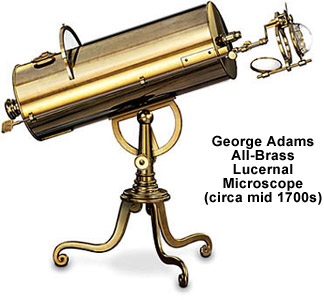George Adams All-Brass Lucernal Microscope
The lucernal microscope was an ingenious development by George Adams (senior), which arose from the basic design of the solar microscope. Adams' development of this class of microscope was described in Essays on the Microscope, etc., a comprehensive treatise written by his son.

Solar, scroll, and lucernal microscopes are described in detail in many volumes dealing with antique microscopes. In the lucernal microscope, the observer's eye and the objective are placed so that they are conjugate with respect to a large convex lens mounted at one end of the cylindrical body tube, adjacent to the stage. The objective projects light from the condensing lens onto the eye or a ground glass screen. Specimens are secured to the external brass stage, which is attached to the body with a dovetail fitting. A plano-concave mirror fitted onto a brass rod supported by the stage is used to enhance specimen illumination. The microscope illustrated above employs a telescope pattern stand for support.
The microscope body serves a double purpose, having a plate containing the eyepiece fitted to one end when the instrument is used as a conventional microscope and a condensing lens that substitutes when the microscope is operated in the lucernal mode. A slot in the body is utilized to house a ground glass plate that serves as a focusing screen. Observers can view specimens projected onto the glass plate and draw the patterns magnified by the microscope.
Adams designed and built a number of lucernal microscopes having both wooden and brass bodies. Some of the microscopes were quite large, having condensing lenses that exceeded eight inches in diameter, with a focal length near 24 inches. These curiosities were very popular during the period, but ultimately vanished from common use and never saw extensive duty as research instruments. The lucernal microscope is now relegated to a footnote in the history of microscopy.
BACK TO EIGHTEENTH CENTURY MICROSCOPES
